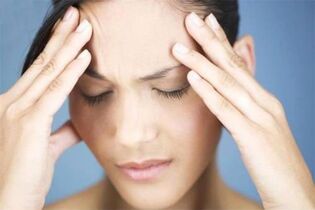Walking upright frees one's hand to perform labor operations - this is an undoubted added value. Along with this, the load on the spine has increased, leading to the development of serious diseases, and this is a colossal minus. Osteochondrosis is one of the most common spinal pathologies. It affects 60% of the world's population aged 35 and over. Surgical intervention is one method of treatment, but alternatives may be made in the early stages of the development of the disease. You can treat osteochondrosis at home. The range of effective therapeutic methods is extensive and affordable.
What is osteochondrosis
Dysfunction and destruction of the intervertebral disc, vertebral tissue is a disease of the musculoskeletal system, called osteochondrosis. Osteocytes are bone cells, and chondrocytes are cartilage cells. Based on these names, the origin of the term "osteochondrosis" is clear. Degenerative-dystrophic changes in the spine negatively affect the general condition of the body.
As the disease progresses, muscle atrophy, impaired nerve impulse flow, physiological systems and individual internal organs do not function. The appearance of pain in the back and neck is the first sign of the disease. Depending on the focal location of the lesion, osteochondrosis is:
- Main symptoms: pain in shoulders, arms, neck; dizziness, tincture, spots in front of the eyes.
- Characterized by dull pain or lumbago in the chest area.
- There is pain in the hip joint, lower back, sacrum. Lower limb function is limited.
- It develops in several parts of the spine at once. It is accompanied by severe pain.
Effective treatment of osteochondrosis at home is possible with timely diagnosis of the disease. It goes through 4 degrees (or levels):
- The pathological process begins with the dehydration of the central part of the intervertebral disc (nucleus pulposus). As a result, the structure recedes, cracks appear on the outside of the disc (annulus fibrosus). This level is almost invisible to the patient. Slight discomfort appears with uncomfortable posture or during active physical activity.
- The distance between adjacent vertebrae decreases due to decreased intervertebral discs. Ligaments and muscles relax. The vertebrae acquire additional mobility. For this reason, they are destitute. This condition is called spondylolisthesis. With a strong load, the patient feels uncomfortable, sometimes pain at the pathological localization.
- The formation of prolapse (hernia), protrusion (uneven protrusion) of the disc, subluxation and arthrosis of the intervertebral joints are major pathological changes in the third stage of the disease. Controlled patient movements, numbness, tingling in the limbs occur. The pain is there, its localization depends on the location of the focus of the disease.
- To eliminate excessive spinal movement, the body forms neoplasms of bone tissue (osteophytes) in the spine. Their formation occurs in a chaotic manner, depending on its location, they can injure the nerve endings of the spinal cord, adjacent vertebrae. The process of obvious structural changes (fibrous ankylosis) begins in the intervertebral joint. The motor segment of the vertebrae looks like "walled up". Signs of osteochondrosis at this stage are practically not felt.
How to treat cervical osteochondrosis at home. How to give first aid at home?
Treatment of cervical osteochondrosis at home includes:
medicine- ;
- physiotherapy;
- urut;
- medical gymnastics;
- diet correction.
Thus, therapeutic methods make it possible to achieve good results in the treatment of cervical osteochondrosis. Symptoms can be very uncomfortable, so you need to know how to give first aid.
Medicine
Various medicines are used to combat the symptoms of the disease. They should be prescribed by a doctor who specializes in the treatment of osteochondrosis - a neuropathologist or vertebrologist.
Medicine

- For severe pain, you can take painkillers such as sodium metamizole. If it does not work, NSAIDs can be taken.
- "Disruption" is sometimes used, such as pepper. By itself, it does not heal, but warms the inflamed area and relieves pain.
- Herbal infusions and diuretics are useful for edema in inflammatory areas.
The following groups of drugs are prescribed for the treatment of SHS:
- Nonsteroidal anti-inflammatory drugs (Nimesulide, Ketoprofen, Meloxicam, Diclofenac and others). Helps relieve pain, swelling and inflammation in the affected nerve roots.
- B group vitamins. They help improve metabolic processes in nerve tissue.
- Chondroprotectors. Promotes cartilage tissue recovery.
- Muscle relaxation (tizanidine, tolperisone hydrochloride). Helps reduce muscle cramps.
- Drugs that aim to improve the rheological properties of blood and blood flow. They help improve the process of blood flow to the brain and nourish the affected nerve endings.
Intramuscular injection may also be indicated.
How to treat osteochondrosis in the cervical and thoracic spine at home. Overview of home treatment
Osteochondrosis of the cervical and thoracic spine, if ignored, causes deformity. Pathological signs:
- pain in the affected area (neck, chest) with little exercise, sudden movement;
- headache;
- dizziness;
- shortness of breath and shortness of breath;
- tired.
If there are any alarming symptoms, you should see a doctor for further diagnosis. If the diagnosis is confirmed, the doctor will determine the stage and prescribe treatment.
Treatment of thoracic and cervical osteochondrosis includes conservative techniques and surgical interventions. At home, you can deal with treatment in the first and second stages of development. With deterioration of the condition, larger vertebral displacement, their melting, defects are removed during surgery.
Treatment of thoracic and cervical osteochondrosis at home is carried out with the help of pharmaceutical preparations, light physical exercise complexes, folk recipes for rubbing, compresses. Doctors recommend visiting the pool, massage therapist, physiotherapy room. Action intended to relieve symptoms:
- muscle relaxation;
- cartilage layer stimulation for regrowth;
- return of vertebrae transferred to its original position;
- the release of pinched nerve fibers.
Treatment of osteochondrosis at home on the cervical and thoracic spine will be effective if all the doctor's recommendations are followed.
Pharmaceutical supplies
Osteochondrosis of the cervix and thorax can be treated at home with the help of medicines - medicines that are commonly available and easily bought in pharmacies. Do not carry out treatment without a doctor's prescription, the wrong medication will slow down the healing process. It is not possible to predict the body's response to drugs. They block pain in the affected area, relieve muscle tone, improve blood circulation, improve metabolic processes, and improve well-being.
Drugs slow down development.
Medication prescribed at home for the treatment of thoracic and cervical osteochondrosis in the chest and neck area:
- Nonsteroidal anti-inflammatory drugs help get rid of inflammation and edema at home. After the course has passed, a decrease in pressure on the spinal arteries and blood vessels is observed in the spinal space.
- Painkillers tablets quickly relieve the sensation of pain and nervous tension.
- Relaxants - a drug that relaxes muscle tissue, relieves pain.
- Preparations based on chondroprotectors for osteochondrosis in the thoracic and cervical spine normalize metabolic processes in cartilage and spinal cord tissue. As a result, it is possible to stimulate the regenerative properties of tissues, increase the gap between the vertebrae, and allow the deformed part to take the desired position. Under the influence of chondroprotectors, pain is rare.
- Vasodilator drugs that increase blood flow to the site of injury. As a result of increased nutrition, the manifestation of symptoms decreases, the correction process is accelerated.
- Vitamins are a useful helper in the treatment of osteochondrosis at home. The reception of groups B, C, E provides the body with the ingredients needed for the fight. They stimulate the healing of cartilage tissue, strengthen the spine, and increase the permeability of nerve fibers.
How to treat osteochondrosis and myositis at home. The main goal of home treatment
A doctor decides to treat cervical osteochondrosis at home if the patient does not have a serious disorder, the symptoms are mild and there are no indications for hospitalization. Selected therapeutic tactics aim to eliminate the manifestations of unpleasant pathological processes and complete the following tasks:
- Normalizes blood circulation in the affected area.
- Elimination of brain hypoxia.
- Normalization of sleep.
- Prevention of rapid disease progression.
- Blood circulation improves.
- Smoothes the regeneration process to restore cartilage tissue.
- Saturation of the body with vitamins and minerals.
- Relieves anxiety, panic attacks, irritability.
- Improves cervical ridge condition.
It is completely impossible to cure chondrosis, but the right approach can slow down the process, restore normal health and maintain a high quality of life for many years. For this, an integrated approach is used, which implies changes in diet, increased physical activity, taking medication, and visiting a massage therapist.
Cervical osteochondrosis can be cured at home simply by adhering to all doctor's recommendations, monitoring diet and taking medication regularly, and performing prescribed therapeutic exercises.
Need to start treatment of cervical chondrosis with pain relief. For this, the specialist chooses the appropriate pain reliever. The pharmaceutical industry offers a wide variety of different products in terms of action, shape and price. With acute unbearable pain, novocaine restriction is possible. Once the main symptomology subsides, the use of alternative techniques is allowed. It can be:
- Massage procedure - relieves cramps, pain and tension.
- Exercise therapy - strengthens muscle tissue, restores normal spinal support, and restores flexibility.
- Mud bath - warms the affected area and relieves pain syndrome for a long time.
- Manual therapy - restores metabolic processes and increases blood flow, eliminating brain oxygen starvation.
- Reflexology - reduces pain in the area, initiates the process of regrowth in cartilage tissue.
- Acupuncture - activates metabolism, improves the condition of cartilage tissue, reduces the manifestation of painful sensations in the affected area.
The most affordable treatment methods at home are ointments, scrubs, baths, stews, compresses. Such traditional medicines have long been known for their safety, ease of use and minimum number of contraindications.
How to treat cervical spine osteochondrosis at home. Symptoms of the disease
Osteochondrosis of the cervical spine at an early stage may not manifest itself in any way. The accompanying signs appear only in the form of advanced pathology, when there is a violation of blood circulation in the brain. This process is usually accompanied by:
- dizziness;
- numb limbs;
- with cool hands and feet;
- "goosebumps" in the eye, dim;
- headache;
- sounds in the head, ringing in the ears;
- increased fatigue;
- irritable;
- lack of coordination;
- running instability;
- tingling, tingling in the neck muscles.

If the disease takes a chronic form, then discomfort and pain always accompany the patient. Main manifestations:
- Painful sensations in the back of the head, neck, shoulders, arms, difficulty moving the head, cracking when turning the head or bending;
- pulls pain in chest area on left side, radiating to left arm, burning sensation between shoulder blades;
- frequent headaches, increased fatigue, weakness, difficulty turning the head;
- pain in neck extends to shoulders and arms, numbness in fingers;
- hearing and vision disorders, numbness of the tongue and face, dizziness, impaired lung and heart function.
Symptoms are divided into three groups:
- neurological manifestations (persistent pain in the neck, pain in muscles, chest, joints);
- pathological effects on spinal cord (weakness in arms and legs, voluntary wrinkles, myelopathy);
- is associated with processes occurring in the brain (cerebral manifestations due to insufficient blood supply: visual disturbances, foreign body sensation in the throat, noise and ringing in the ears, hearing loss, dizziness, walking instability, fainting, fatigue, irritability, sleep disorders, decreased ability to remember).





































